How Does Brand Photography/Videography Enhance Brand Storytelling?
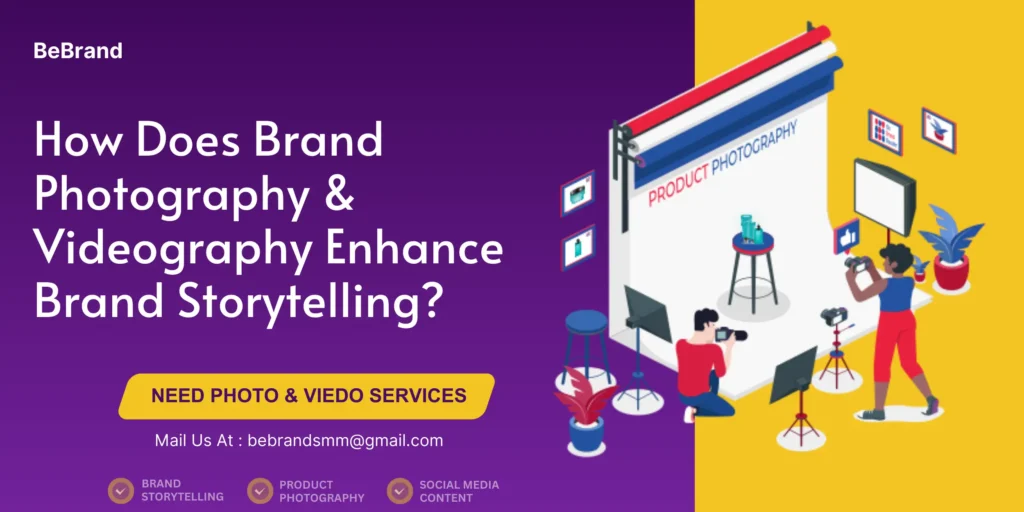
In today’s highly visual world, telling your brand’s story has become more than just words. While traditional storytelling relied on written or spoken content, the power of brand photography/videography takes your narrative to new heights. Every picture, video, or short clip can help your brand connect with people on a deeper, emotional level. In this blog post, we’ll dive into how brand photography and videography enhance storytelling, create stronger connections with your audience, and ultimately, boost your brand’s overall visibility and appeal. What is Brand Photography/Videography? Brand photography and videography are visual tools that companies use to communicate their values, products, services, and brand personality to their audience. It’s not just about taking pretty pictures or videos—it’s about creating content that resonates with your target audience and aligns with the brand’s mission, goals, and identity. Think of it as capturing the essence of your brand in visual form. Brand photography/videography shows your audience who you are, what you do, and why it matters, often in a single glance. It’s one of the most powerful ways to tell your brand’s story because visuals can evoke emotions more effectively than words alone. The Power of Visual Storytelling Humans are visual creatures. We process visuals 60,000 times faster than text, and we tend to remember pictures or videos much more vividly. This means that a well-crafted image or video can stick in the minds of your audience far longer than a paragraph of text might. Brand Photography: A Picture Says More Than a Thousand Words When it comes to photography, capturing your brand’s essence is critical. The images you use on your website, social media, or marketing materials should reflect the personality, values, and goals of your brand. The colors, lighting, background, and subject matter should all work together to tell a cohesive story about who you are. Let’s take a simple example: if your brand focuses on sustainability and eco-friendly products, your photos should feature natural elements, earthy tones, and showcase your products in environmentally friendly settings. You’re not just selling a product—you’re selling a lifestyle, a belief system that resonates with people who care about the planet. Brand Videography: Making Your Story Come to Life Videography takes brand storytelling a step further by adding movement, sound, and more complex visual elements. With video, you can dive deeper into the emotions and atmosphere you want to convey. For instance, a short behind-the-scenes video showing how your product is made adds a personal touch to your brand. It humanizes your company and builds trust with your audience. People enjoy knowing the story behind what they buy—the faces, hard work, and passion behind the scenes. In a video, you can show the process, capture the sounds of nature if it’s an outdoor scene, or even use background music that aligns with your brand’s identity to create an emotional connection with your viewers. How Brand Photography/Videography Builds Emotional Connections When you see a beautiful image or an engaging video, your brain reacts emotionally, often before it reacts rationally. That’s the beauty of visuals—they tap into human emotions quickly and effectively. This emotional response is what makes visual storytelling such an integral part of marketing today. Creating Trust and Authenticity One of the most significant aspects of brand storytelling is building trust. Authentic photography or videography can make your brand feel more human. It shows that real people are behind the products or services you offer, creating an emotional bond between your brand and your customers. For example, showing the faces of your team members in a candid setting, rather than a stiff corporate photo, can make your business seem more approachable and relatable. Or, showcasing customer testimonials through video can create an authentic story of how your product has positively impacted real lives. Highlighting Brand Values Through brand photography/videography, you can visually communicate your core values. What values does your company hold? What feelings do you want your customers to have when they connect with your brand? Use imagery that reflects these values consistently across all platforms. For instance, if one of your brand’s key values is innovation, your videos should feel modern and cutting-edge, with quick transitions, futuristic graphics, and forward-thinking content. Alternatively, if your brand values tradition and craftsmanship, your photography may focus on detailed, artisan shots, with warm, inviting colors and settings. Real-Life Story: The Power of Authenticity A small coffee roaster brand in California struggled to build an online following. Their products were fantastic, but they just weren’t resonating with their audience. After hiring a photographer and videographer to create authentic, behind-the-scenes content—showing the roasting process, the passionate team, and the dedication to sustainable practices—the brand saw an increase in social media engagement and a rise in online sales. Customers commented on how much they loved seeing the “real” faces behind the coffee and how the story made them feel connected to the brand. This is the magic of brand photography/videography—building emotional bonds through authenticity. Increasing Brand Recognition Incorporating high-quality visual content also helps your brand stand out in a crowded market. Consumers are constantly bombarded with information, and visuals can help your brand be remembered. Consistency is Key To enhance your brand’s story, consistency is crucial. Your visual content should maintain a cohesive style across all platforms, including your website, social media, emails, and ads. This consistency helps create a recognizable and memorable brand. Let’s take an example of Apple, a brand known for its clean, minimalistic design. Whether you’re looking at their product photos, commercials, or website, everything aligns with their brand image. This consistency is one reason Apple is so successful at brand recognition. A Case Study: Nike’s “Just Do It” One of the best examples of how brand videography enhances storytelling is Nike’s famous “Just Do It” campaign. The powerful videos showcase athletes of all kinds—professionals, amateurs, and even those overcoming tremendous odds—pushing themselves to the limit. The story isn’t just about selling shoes; it’s about inspiration, determination, and the spirit of never giving up. Nike
What is Graphic Design, and How Can It Enhance Customer Experience?
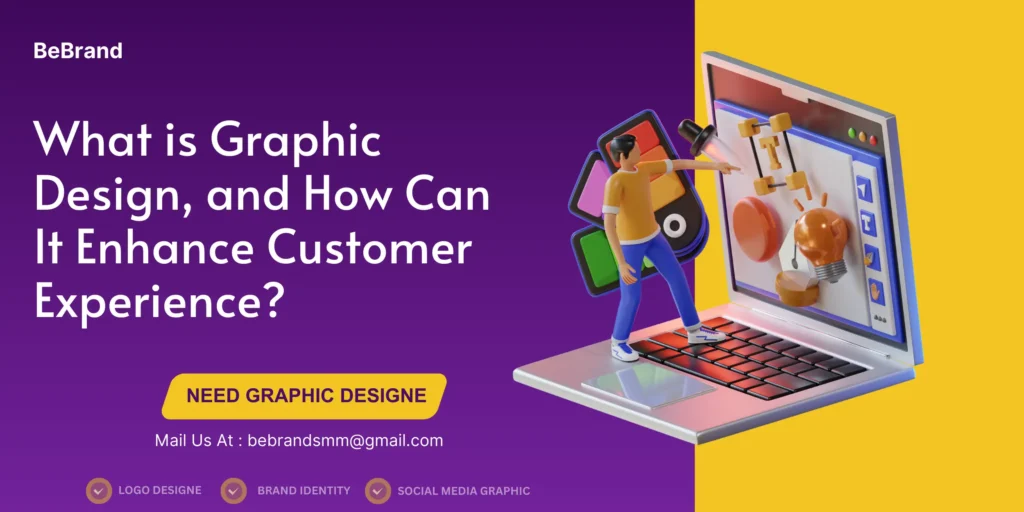
Nowadays, with everything moving so quickly online, making a great first impression is more important than ever. Whether it’s a website, a business card, or an advertisement, the visuals are often the first thing people notice. That’s where the power of graphic design shines. It’s not just about making things “look nice”—graphic design is a powerful tool that shapes how customers perceive a brand and influences their experience. In this blog post, we will explore what graphic design is and how it can enhance the customer experience, creating lasting relationships between businesses and their audiences. What is Graphic Design? Simply put, graphic design is all about crafting visual content to get your message across.. Designers use typography, images, colors, and layouts to craft visual solutions that inform, engage, and inspire people. Graphic design can be found everywhere—from websites and logos to product packaging, advertisements, social media graphics, and much more. But graphic design goes beyond just making things aesthetically pleasing. It’s about strategically using visuals to convey a message, solve problems, and deliver a better user experience. In business, this means creating designs that resonate with the target audience, helping them connect emotionally with the brand and ultimately driving them to take action. How Graphic Design Boosts Customer Experience Now that we understand the basics of graphic design, let’s dive into how it can enhance the customer experience. In today’s market, customers expect more than just a product or service—they want a seamless, engaging experience from start to finish. And graphic design plays a crucial role in making that happen. First Impressions and Branding We’ve all heard the saying, “You never get a second chance to make a first impression.” This is especially true for businesses. The moment a potential customer visits your website, sees your logo, or interacts with your marketing materials, they form an opinion about your brand. Good graphic design ensures that this first impression is a positive one. Take, for example, Apple. Their sleek, minimalist design approach isn’t just visually appealing—it communicates innovation, simplicity, and premium quality. From their website to their packaging, every design element reinforces their brand message. As a result, customers associate Apple with cutting-edge technology and an exceptional user experience. Clarity and Communication In a world full of information overload, it’s easy for messages to get lost in the noise. Graphic design helps cut through the clutter by presenting information in a clear, concise, and visually engaging way. When customers can easily understand what you’re offering and how it benefits them, they are more likely to engage with your brand. For example, a well-designed infographic can take complex data and present it in a way that is easy to digest. This boosts the user experience and helps earn your audience’s trust. When your design makes things simple and intuitive, customers appreciate the effort and are more likely to stick around. Consistency Builds Trust One of the most overlooked aspects of graphic design is consistency. A consistent design across all platforms—whether it’s your website, social media, or printed materials—reinforces your brand identity and builds trust with your audience. Customers are more likely to trust a brand that looks professional and cohesive. Think about brands like Coca-Cola. No matter where you see their logo, colors, or fonts, it’s instantly recognizable. This consistency creates a sense of reliability and familiarity, which is key to building long-term relationships with customers. Enhancing User Experience (UX) on Websites When it comes to websites, graphic design and user experience (UX) go hand in hand. A great-looking website is just part of the picture. It should also be easy for users to find what they need, explore the content smoothly, and take actions like buying something or subscribing for updates. Imagine visiting a cluttered, visually overwhelming website where the fonts are hard to read, the buttons are misplaced, and you can’t find the information you need. Frustrating, right? Now, imagine visiting a clean, well-organized website where everything is intuitive and visually appealing. You’re more likely to spend time on the site, explore what it offers, and ultimately make a purchase. Emotional Connection and Storytelling Graphic design isn’t just about logic and clarity—it’s also about evoking emotions. Great design has the power to tell a story and connect with customers on a deeper, emotional level. Whether it’s through the use of colors, imagery, or typography, design can make customers feel inspired, excited, comforted, or even nostalgic. For example, Nike’s “Just Do It” campaign has been iconic for years, not just because of the slogan, but because of the powerful visuals that accompany it. The bold, dynamic design and images of athletes overcoming challenges evoke feelings of determination and empowerment, which resonate deeply with their target audience. Real-Life Story: How Graphic Design Boosted Customer Engagement Let’s take a look at a real-life example. A small e-commerce business selling eco-friendly products wanted to revamp their website to improve sales. They invested in a professional graphic designer to redesign the website, focusing on creating a clean, visually appealing layout that showcased their products in an attractive way. The designer also created custom icons and illustrations to communicate the brand’s sustainability mission clearly. Within a few months of launching the new design, the company saw a significant increase in website traffic, customer engagement, and sales. The improved design not only made the site easier to navigate but also helped customers connect with the brand’s values, leading to higher customer loyalty. Common FAQs About Graphic Design Now, let’s address some of the most common questions people have about graphic design. How does graphic design differ from web design? Graphic design focuses on creating visual content for a variety of media, including print and digital, whereas web design is specifically concerned with designing websites. While graphic designers may create visuals for a website, web designers are responsible for the site’s layout, functionality, and overall user experience. What tools do graphic designers use? Graphic designers typically use software like Adobe Photoshop, Illustrator, and InDesign for creating visuals.
What is Social Media Marketing, and How Vital is it for Targeting Your Audience Effectively?
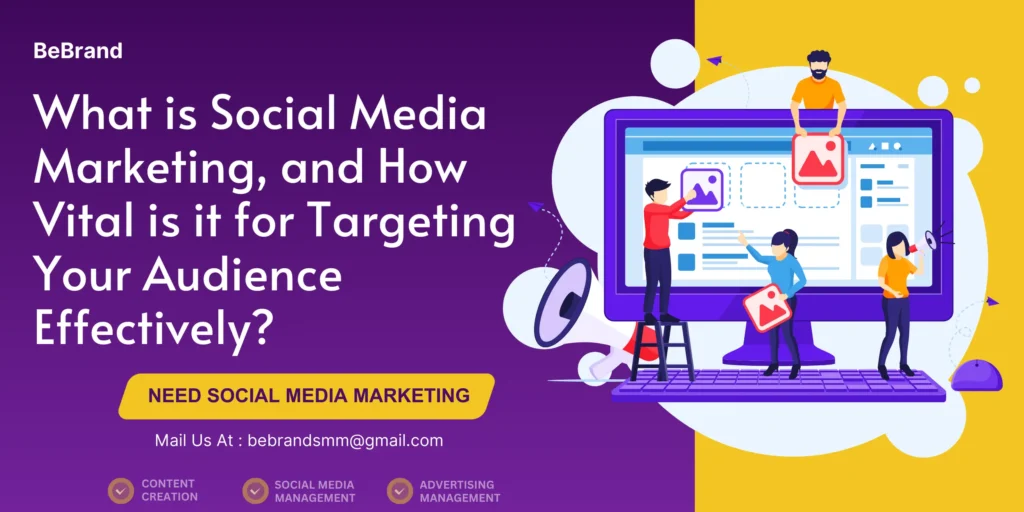
At its core, social media marketing involves using social media platforms to promote your brand, products, or services. This strategy encompasses a range of activities, from creating engaging content to managing interactions with followers. The platforms used can include Facebook, Twitter, Instagram, LinkedIn, TikTok, and many others. Why Social Media Marketing Matters With billions of people using social media worldwide, businesses have an unparalleled opportunity to connect with their audience. Social media marketing allows brands to engage directly with customers, build relationships, and ultimately drive sales. Here are a few key reasons why social media marketing is so vital: Widespread Reach: Social media platforms have millions, if not billions, of users. This vast audience provides an incredible opportunity for businesses to reach potential customers who may not be aware of their brand otherwise. Targeted Advertising Social media platforms offer sophisticated targeting options that enable businesses to reach specific demographics. For example, if you’re a fitness brand, you can target your ads to users interested in health and wellness. Cost-Effectiveness Compared to traditional advertising methods, social media marketing is often more affordable. Many platforms allow businesses to run ads with smaller budgets, making it accessible for startups and small businesses. Real-Time Engagement Social media allows for instant communication with customers. Whether answering questions or addressing concerns, businesses can engage with their audience in real time. Building Brand Loyalty Consistent and genuine engagement with followers fosters brand loyalty. When customer feel a connection with a brand, they’re more likely to pick it over others. Crafting Your Social Media Marketing Strategy To create a winning social media marketing plan, you need to be strategic. Here are some key steps to keep in mind: 1. Define Your Goals Before diving into social media marketing, it’s crucial to establish clear objectives. What do you hope to achieve? Common goals include: Increasing brand awareness Generating leads Driving website traffic Boosting sales 2. Identify Your Target Audience Understanding who your audience is will shape your content and marketing efforts. Look into who your audience is, what they like, and how they spend their time online. Consider using tools like Facebook Insights or Google Analytics to gather valuable data about your audience. 3. Choose the Right Platforms Not all social media platforms are created equal. Depending on your target audience and business goals, you may want to focus your efforts on specific platforms. For instance, Instagram is ideal for visually appealing brands, while LinkedIn is perfect for B2B marketing. 4. Create Engaging Content Content is king in social media marketing. Your posts need to inform, entertain, and engage. Try using a mix of different content types, like: Images and videos: Visual content tends to perform better and captures attention quickly. Blogs and articles: Share useful and valuable information that your audience will appreciate. Polls and questions: Encourage engagement by asking your followers for their opinions. 5. Monitor and Analyze Performance Regularly track your performance using analytics tools. Look at engagement rates, click-through rates, and conversions to see what’s working and what needs improvement. Use this information to shape your next marketing moves. Real-Life Stories: The Impact of Social Media Marketing The Small Bakery That Could Let’s take a moment to look at a small bakery called “Sweet Treats.” Located in a quiet neighborhood, Sweet Treats struggled to attract customers in the beginning. After realizing they needed to embrace social media marketing, the owner, Sarah, decided to create an Instagram account. Sarah began sharing mouth-watering photos of her baked goods, engaging with followers through contests and polls. She also used Instagram Stories to showcase the behind-the-scenes process of baking. Within a few months, Sweet Treats gained a substantial following. Customers began flocking to the bakery, excited to try the new treats they had seen online. Sarah’s use of social media transformed her business, proving the power of engaging content in reaching a local audience. The Fitness Coach Who Built a Community Another inspiring story is that of Jake, a fitness coach who wanted to expand his reach beyond his local gym. With a passion for fitness and a knack for creating engaging videos, Jake turned to TikTok for social media marketing. He began sharing workout tips, healthy recipes, and motivational content. His energetic personality resonated with viewers, and before long, Jake built a community of fitness enthusiasts. He used his growing platform to offer online training programs, significantly increasing his income. Jake’s success showcases how social media marketing can create genuine connections and build a loyal customer base. FAQs About Social Media Marketing What is the best platform for social media marketing? The best platform for your business hinges on understanding your audience and your specific goals.. For visual brands, Instagram and Pinterest are ideal. For B2B businesses, LinkedIn is a strong choice. Research where your audience spends their time online to determine the right platforms for you. How frequently should you be posting on social media? Consistency is key in social media marketing. Aim to post at least a few times a week, but find a frequency that works for your audience and resources. Quality is more important than quantity, so focus on creating engaging content rather than overwhelming your followers with posts. How do I measure the success of my social media marketing efforts? Track key performance indicators (KPIs) such as engagement rates, website traffic, conversions, and follower growth. Use analytics tools provided by social media platforms to gain insights into your performance and adjust your strategy accordingly. Can I do social media marketing on my own? Absolutely! While hiring a professional can be beneficial, many small businesses successfully manage their social media marketing in-house. Start small, learn as you go, and use available resources to enhance your knowledge. What should I do if my social media marketing isn’t working? If you’re not seeing results, assess your strategy. Are you engaging with your audience? Is your content resonating with them? Consider experimenting with different types of content or changing your posting schedule. Don’t be
Why are SEO and Local SEO Vital for Boosting Local Business Success Online?
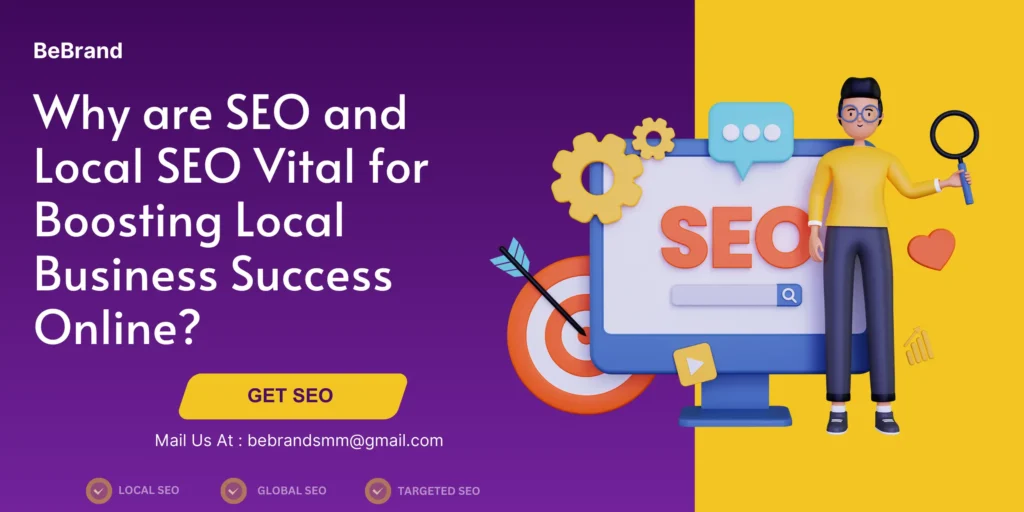
In today’s fast-paced digital world, having a strong online presence is not just an option—it’s a necessity for any local business aiming to grow and thrive. And to truly get ahead, Search Engine Optimization (SEO) and Local SEO are key tools that can help you stand out. Whether you’re running a local bakery, a repair shop, or even a small consultancy firm, mastering SEO and Local SEO can make a world of difference in how your business performs online. In this post, we’ll explore why SEO and Local SEO are so vital for local business success, break down how they work, and look at real-life examples of businesses that have benefited from them. We’ll also tackle some common FAQs about SEO to give you a solid understanding of how it all fits together. 1. What is SEO and How Does It Work? SEO, short for Search Engine Optimization, is the process of improving your website so it ranks higher on search engines like Google. In simple terms, SEO helps your business be more visible when someone searches for products or services that you offer. The better your SEO, the higher your website appears in search results, leading to more clicks, more visits, and hopefully more sales. The way SEO works is a combination of optimizing various aspects of your website. This includes: On-page SEO Optimizing content and HTML code on your website. This includes using the right keywords, meta descriptions, headings, and more. Off-page SEO Building external backlinks from other websites to your own, which tells search engines that your site is trustworthy and authoritative. Technical SEO Making sure your website is fast, mobile-friendly, and easy for search engines to crawl and index. 2. Local SEO: Targeting Customers in Your Area While general SEO aims to get your website ranking globally or nationally, Local SEO focuses on reaching potential customers in your local area. This is crucial for businesses that operate on a local scale, like restaurants, local services, or stores. Local SEO helps businesses show up in localized searches, such as “plumber near me” or “best coffee shop in [city].” Local SEO involves optimizing your website and online presence to ensure that it shows up in local search results, Google Maps, and even voice searches. A key part of Local SEO is setting up and optimizing your Google Business Profile (GBP)—formerly known as Google My Business. This allows your business to appear in Google’s Local Pack, which is the map section that appears at the top of local search results. Why Local SEO is so important: Increased visibility Your business gets seen by people in your area who are searching for services you offer. Better foot traffic By appearing in Google Maps and local search results, you’re more likely to attract people who are looking for nearby options. Higher conversions Local searches often lead to quick decisions. If someone searches for a “coffee shop near me,” there’s a good chance they’re about to make a purchase. 3. Why SEO and Local SEO are Vital for Local Business Success 3.1. SEO Improves Visibility and Credibility When your website ranks higher in search results, potential customers are more likely to trust your business. The top few results are often seen as more credible and trustworthy. This increased visibility doesn’t just mean more clicks but also enhances your brand’s reputation. Ranking higher tells users that you are a leader in your niche, which can result in increased customer loyalty. For instance, a local bookstore that invests in SEO can outrank national chains in local searches, ensuring that people in their community find their store first. 3.2. Local SEO Drives More Qualified Traffic One of the major benefits of Local SEO is that it brings in qualified traffic—people who are genuinely interested in your product or service and are close enough to act on it. Instead of casting a wide net, Local SEO helps you focus on people who are geographically closer and more likely to convert into paying customers. Consider this: someone searching for a “hair salon in downtown” is likely to visit a nearby salon the same day or in the near future. By showing up in this search, you’re not just getting a click but a potential customer who is ready to make a purchase decision. 3.3. Mobile Usage Makes Local SEO Even More Essential With the growing use of smartphones, most people search for local businesses on their mobile devices. In fact, studies show that over 60% of all searches are now performed on mobile, and many of these are location-based. By optimizing your business for Local SEO, you can capture this growing segment of customers who are on-the-go and looking for quick, local solutions. 3.4. SEO and Local SEO Are Cost-Effective Marketing Tools Compared to traditional advertising methods like print, radio, or TV ads, SEO and Local SEO are far more cost-effective. Once you’ve optimized your website, it continues to work for you over time, attracting new visitors and customers without requiring additional ad spend. While SEO does require some upfront investment (either in time or money), it delivers long-term results. Imagine a restaurant that invests in Local SEO. By showing up at the top of search results when people look for “best pizza near me,” they get more walk-ins without needing to spend continuously on ads. 4. Real-Life Examples of SEO Success for Local Businesses 4.1. The Case of the Local Bakery Let’s take the example of a small bakery in a medium-sized town. The owners initially relied on word of mouth and social media to attract customers. But after implementing Local SEO—optimizing their Google Business Profile, updating their website with relevant keywords like “best bakery in [town],” and gathering positive reviews—they saw a significant increase in foot traffic. Their bakery began appearing in the top local results for terms like “fresh bread near me” and “best cupcakes in [town].” As a result, they started getting new customers who had never heard of them before
What is Website Development, and Why Does It Matter?
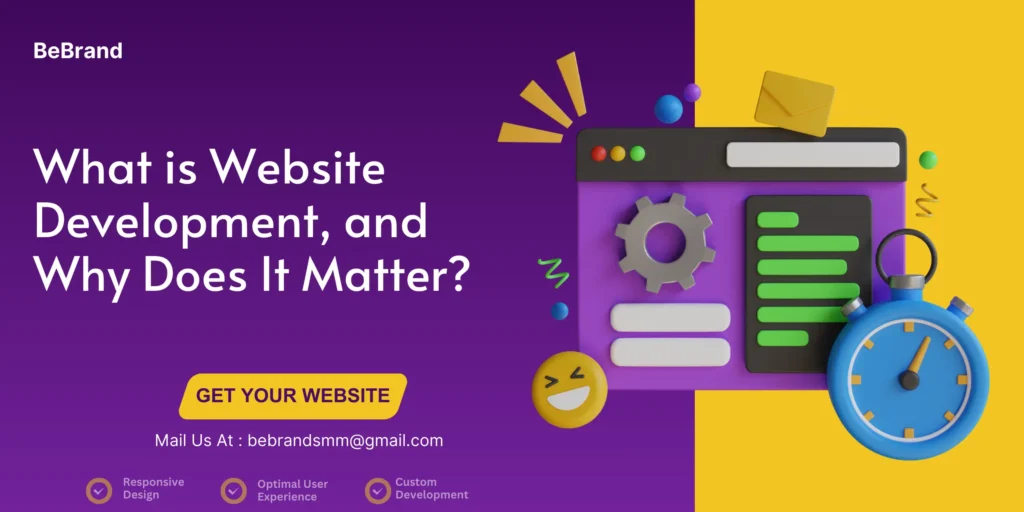
In today’s digital age, every business, big or small, needs a strong online presence to survive and thrive. This is where website development comes in. But what exactly is website development, and why is it such a big deal? Let’s dive into this topic and explore why having a well-developed website can be a game changer for your business. What is Website Development? The process of building and managing websites is known as website development. Web design, web content production, client-side/server-side scripting, and network security configuration are just a few of the duties involved. In essence, website development is all about building and updating websites to keep them functional, user-friendly, and visually appealing. But website development isn’t just about making a site look good; it’s about creating an experience that visitors will find valuable. A well-developed website is not only easy to navigate, but it also works efficiently across different devices (such as smartphones, tablets, and desktops). Plus, it should load quickly and offer a seamless experience, no matter how heavy the traffic gets. Key Elements of Website Development To better understand what website development entails, let’s break it down into its key elements: Front-End Development This is what users interact with when they visit a website. It includes the design, layout, and content. Front-end developers use languages like HTML, CSS, and JavaScript to ensure the site looks good and functions properly on the user’s end. Back-End Development While the front end is what visitors see, the back end is the behind-the-scenes aspect that makes the website run smoothly. This involves server management, databases, and applications, all of which ensure that the website performs well. Content Management Systems (CMS) Tools like WordPress, Joomla, or Drupal that allow you to create, manage, and modify content on your website without needing to have advanced technical skills. CMS platforms make website management more accessible, even for beginners. Security A crucial part of website development is ensuring that your site is secure from cyber-attacks. This includes installing firewalls, SSL certificates, and encryption to protect sensitive data like customer information. Why Website Development Matters Maybe you’re thinking, “Why should website development matter to me?” Well, here’s the reality: your website is often the first point of contact between you and your customers. First impressions matter, and a poorly developed website can leave a negative impact that drives potential customers away. Here’s why website development is crucial: First Impressions Count When someone visits your website, they instantly form an opinion about your business based on its look and functionality. A clean, easy-to-navigate site shows that you’re professional and trustworthy. On the flip side, a slow, cluttered, or outdated website can make visitors question your credibility. User Experience (UX) A well-developed website prioritizes user experience. This means ensuring that visitors can easily find the information they need without any hassle. If your site is difficult to navigate, users are likely to leave and find a competitor’s site instead. A smooth and pleasant user experience keeps people engaged, increasing the chances that they’ll become customers. Mobile Optimization In 2024, more than half of all internet traffic comes from mobile devices. If your website isn’t mobile-friendly, you’re missing out on a huge chunk of potential business. A well-developed site will automatically adjust to different screen sizes, ensuring it looks great on phones, tablets, and desktops alike. Search Engine Optimization (SEO) Website development plays a significant role in your search engine ranking. Search engines like Google prefer websites that are fast, secure, and mobile-friendly. By following best practices in web development, you can improve your site’s visibility on search engines, driving more organic traffic to your business. Scalability Your website must expand in tandem with your company’s growth. You may add new features, pages, and content to a well-designed website without having to start from scratch since it is scalable.In the long run, this helps you save both time and money. Real-Life Story: The Impact of Website Development Let me share a real-life example that highlights the importance of website development. Sarah owned a small local bakery that relied on word-of-mouth marketing and a few Facebook posts to attract customers. She had a website, but it was outdated, slow, and not mobile-friendly. After realizing she was losing customers who couldn’t easily browse her site on their phones, Sarah decided to invest in proper website development. She hired a developer to redesign her website, making it mobile-optimized, visually appealing, and easy to navigate. The results were astonishing! Within a few months, Sarah saw a 30% increase in online orders and a noticeable boost in foot traffic to her bakery. She also started ranking higher in local search results, attracting more customers from her area. Sarah’s story shows that a well-developed website can significantly boost your business by improving user experience and visibility. Common FAQs About Website Development What’s the difference between web design and web development? Web design is focused on the look and feel of a website—how it’s visually presented to users. Web development, on the other hand, is more technical and involves building the website’s structure, coding, and making sure everything works properly. Wondering how much time it takes to build a website? The time it takes to develop a website depends on its complexity. A simple website with a few pages may take a few weeks, while a more complex site with advanced features, such as e-commerce capabilities or membership portals, could take several months. What are the key steps in developing a website? Key steps include planning, designing, content creation, coding, testing, and launching. Every step matters in creating a successful website. Why is website security important, and how can it be ensured? Security protects against threats like hacking and data breaches. Use strong passwords, SSL certificates, and regular updates to enhance security. What’s the importance of website maintenance? Once your website is developed, it’s crucial to keep it updated and well-maintained. Regular updates ensure that your site stays secure, functions properly, and adapts to any
How Does Aerial Footage Boost Marketing
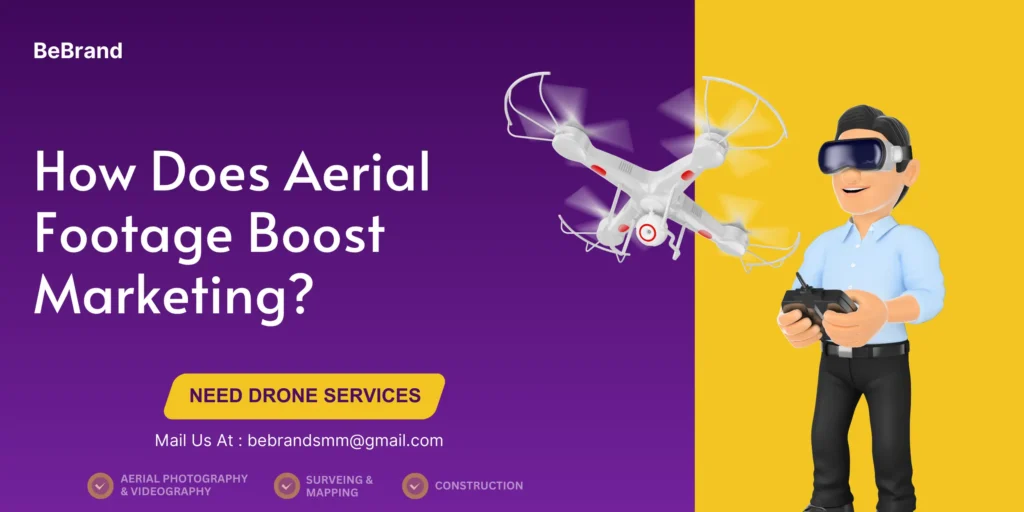
In today’s digital age, marketers are constantly looking for new ways to capture their audience’s attention. As consumers become increasingly visually driven, businesses must keep pace with trends that make a lasting impression. One trend making waves in the marketing world is aerial photography and videography. Whether it’s a breathtaking shot of a sprawling city or an expansive view of a vineyard, aerial footage brings a fresh, engaging perspective that other forms of media simply can’t match. But how exactly does aerial footage enhance marketing? Let’s explore how this innovative technique is becoming a game-changer for businesses of all sizes. Aerial Footage Offers a Unique Perspective One of the main reasons aerial photography/videography is so powerful in marketing is that it provides an entirely different perspective. Traditional ground-level shots are effective, but they can become monotonous over time. Aerial footage, however, shows viewers an angle they wouldn’t normally see, offering a more dynamic and visually captivating experience. For instance, think about a real estate company marketing a property. Ground shots may show the house, but aerial footage can capture the entire neighborhood, nearby amenities, and even show off the home’s proximity to parks, schools, or scenic views. This added context allows potential buyers to see the bigger picture—literally! Similarly, aerial footage can transform how travel agencies present vacation spots. Aerial shots of resorts, beaches, and tourist attractions give potential customers an exciting, panoramic preview of their vacation. It’s no wonder why companies across various industries are jumping on the aerial bandwagon. Increased Engagement on Social Media Social media platforms thrive on eye-catching visuals, and aerial footage delivers exactly that. Whether it’s a dramatic overhead shot of a cityscape or the sweeping view of a sunset over the mountains, aerial footage tends to perform better on social media than regular photography. According to research, video content is more engaging than still images, and aerial videography takes that engagement to a new level. Viewers are drawn to its novelty and scope, making them more likely to interact, comment, share, or even visit a company’s website. For brands looking to boost their social media presence, incorporating aerial footage into their content strategy can lead to higher levels of audience interaction and a stronger online presence. Real-life Story: A Winery’s Social Media Success Consider the story of a small family-owned winery that was struggling to stand out on social media. They decided to hire a drone videographer to capture aerial footage of their vineyard, showing off the beautiful rows of vines and the surrounding countryside. After posting the video on social media, the post went viral, gaining thousands of views, shares, and new followers. The winery’s social media engagement skyrocketed, and their video became an essential part of their brand’s storytelling. It demonstrated how aerial footage can give a company the visibility it needs to grow in a crowded market. Enhanced Storytelling Aerial photography and videography enhance storytelling in a way that traditional media cannot. Instead of simply telling customers about your product or service, you can show them. This “show, don’t tell” approach resonates deeply with audiences and allows businesses to craft a more immersive narrative. Imagine you’re marketing an eco-friendly resort. Rather than just saying it’s located in the middle of lush forests, aerial footage can transport potential visitors into the heart of the forest, showing them the vast greenery, nearby rivers, and mountains. This creates a powerful emotional connection and makes the story come alive. Highlighting Scale and Context Aerial footage is especially useful for highlighting the scale of large projects or developments. For instance, construction companies use aerial videography to showcase the size and scope of their projects, which can be difficult to capture from the ground. Similarly, event planners use aerial footage to showcase the grandeur of a festival, wedding, or corporate event. By flying a drone overhead, they can capture the full crowd, venue, and surroundings, giving viewers a clear sense of the event’s scale and atmosphere. Real-life Story: A Construction Company’s Unique Pitch A construction company recently used aerial footage in their pitch to a potential client. They included drone shots of their previous projects, showcasing the size and scope of the buildings they had constructed. This allowed the client to see not only the finished product but also the construction process, from breaking ground to completion. The visual impact of the aerial footage helped the company secure the contract, illustrating how aerial videography can serve as a powerful marketing tool in competitive industries. Cost-Effective and Time-Efficient You might assume that using aerial photography or videography is expensive, but it’s actually quite cost-effective. With advances in drone technology, businesses no longer need to rent helicopters or planes to get that perfect overhead shot. Drones are affordable, easy to operate, and can capture high-quality footage quickly. Additionally, aerial footage can be reused across different marketing platforms, making it an even smarter investment. You can repurpose drone footage for social media, websites, email campaigns, and advertisements without incurring additional costs. Standing Out From Competitors In a busy market, businesses have to find unique ways to stand out from the competition. Aerial footage provides a fresh, innovative way to make your brand stand out. Since it’s still relatively new compared to traditional photography and videography, companies that use aerial footage can position themselves as forward-thinking and cutting-edge. For example, aerial shots of a hotel’s rooftop pool, restaurant, or lounge area can help a hospitality brand stand out from its competition. While competitors may have great ground-level shots, the addition of stunning aerial views offers that extra wow factor. FAQs About Aerial Footage How high can drones fly for aerial photography/videography? Drones can typically fly up to 400 feet, which is the limit set by most aviation authorities. This altitude is sufficient to capture expansive landscapes, buildings, and events while adhering to safety guidelines. Is aerial footage suitable for all businesses? Yes! Aerial footage can be adapted to many industries, from real estate
